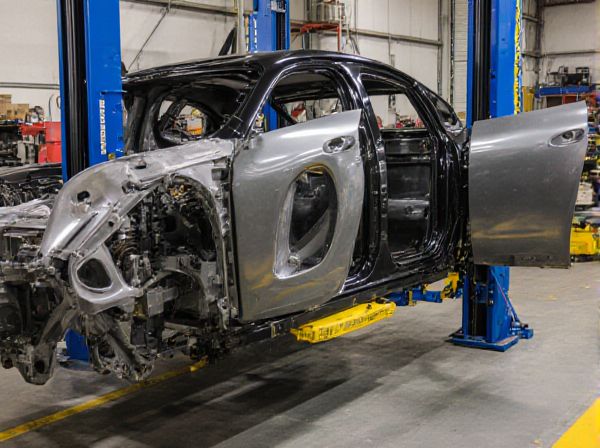
Photo illustration: Integral Frame vs Body-on-Frame
Integral frame vehicles combine the body and chassis into a single unit, offering enhanced rigidity and reduced weight for improved fuel efficiency and handling. Body-on-frame construction features a separate body mounted on a durable frame, providing superior strength and durability ideal for off-road driving and heavy towing. Your choice depends on whether you prioritize comfort and efficiency or ruggedness and load-bearing capability.
Table of Comparison
| Feature | Integral Frame | Body-on-Frame |
|---|---|---|
| Structure | Unibody design combining frame and body | Separate body mounted on a rigid frame |
| Weight | Lighter overall vehicle weight | Heavier due to separate chassis |
| Strength & Durability | Less suited for heavy-duty use | High strength, ideal for off-road & towing |
| Safety | Better crash energy absorption | Less effective in crash energy management |
| Cost | Lower manufacturing cost | Higher production cost |
| Repair & Maintenance | More complex repairs | Easier to repair damaged frame or body |
| Common Usage | Passenger cars, sedans, SUVs | Trucks, large SUVs, off-road vehicles |
Introduction to Vehicle Frame Structures
Integral frame structures, commonly known as unibody designs, combine the vehicle's body and frame into a single cohesive unit, enhancing overall rigidity and reducing weight for improved fuel efficiency and handling. Body-on-frame construction features a separate, robust frame supporting the drivetrain and suspension, offering superior durability and ease of repair, especially favored in trucks and off-road vehicles. Understanding these fundamental differences is crucial for optimizing vehicle performance, safety standards, and application-specific requirements in automotive engineering.
What is an Integral (Unibody) Frame?
An Integral (Unibody) Frame combines the vehicle's body and chassis into a single cohesive structure, enhancing rigidity and reducing overall weight. This design improves fuel efficiency and handling by distributing stress across the entire frame, unlike traditional Body-on-Frame vehicles where the body sits on a separate frame. Integral frames are commonly used in passenger cars and crossover SUVs due to their superior crash safety and ride comfort.
What is a Body-on-Frame Construction?
Body-on-frame construction features a separate body mounted on a rigid ladder-like frame, providing enhanced durability and off-road capability. Commonly used in trucks and SUVs, this design allows for easier repairs and better resistance to torsional stress during heavy-duty use. Unlike integral frame designs, body-on-frame vehicles offer superior load-bearing capacity and customization options for rugged terrains.
Key Structural Differences
Integral frame, also known as unibody construction, integrates the vehicle's body and frame into a single cohesive structure, enhancing rigidity and reducing weight for improved fuel efficiency and handling. Body-on-frame design features a separate, robust frame to which the body is mounted, offering superior durability and ease of repair, ideal for heavy-duty and off-road applications. The key structural difference lies in unibody's unified chassis-body build versus body-on-frame's distinct frame and body assembly, significantly impacting vehicle performance and application suitability.
Strengths of Integral Frame Design
Integral frame design maximizes structural rigidity by integrating the vehicle's body and chassis into a single, cohesive unit, enhancing overall strength and crash safety. This design reduces vehicle weight compared to body-on-frame construction, improving fuel efficiency and handling dynamics. Integral frames also provide superior torsional stiffness, which contributes to better ride comfort and precise steering response.
Advantages of Body-on-Frame Vehicles
Body-on-frame vehicles offer superior towing capacity and durability, making them ideal for heavy-duty applications and off-road driving. Their separate frame design absorbs impacts better, enhancing repairability and longevity in rugged conditions. This construction also allows for easier modification and customization, appealing to truck enthusiasts and professionals requiring specialized equipment.
Common Applications: Integral vs Body-on-Frame
Integral frames, also known as unibody constructions, are commonly used in passenger cars and crossover SUVs due to their lighter weight and improved fuel efficiency, enhancing handling and comfort. Body-on-frame designs are prevalent in trucks, large SUVs, and off-road vehicles because they provide superior strength, durability, and ease of repair for heavy-duty applications. The choice between integral and body-on-frame depends on the vehicle's intended use, with integral favored for everyday driving and body-on-frame preferred for rugged performance and load-bearing capacity.
Ride Quality and Safety Comparison
Integral frame vehicles offer enhanced ride quality due to their unified chassis and body structure, which reduces vibrations and improves handling precision. Body-on-frame designs excel in safety for off-road and heavy-duty impacts, as the separate frame absorbs shocks better and prevents deformation of the passenger cabin. Studies indicate that while integral frames provide superior comfort and stability on paved roads, body-on-frame vehicles demonstrate greater durability and occupant protection in rugged conditions.
Maintenance and Repair Considerations
Integral Frame vehicles feature a unibody construction that allows for fewer parts and generally easier access during maintenance, resulting in lower repair costs and faster service times. Body-on-Frame designs, common in trucks and SUVs, separate the frame and body, making repairs more modular but often more labor-intensive due to the complexity of disconnecting components. Rust and structural damage on Body-on-Frame vehicles typically require more extensive repairs compared to the more integrated Integral Frame, which tends to have better corrosion resistance and structural longevity.
Future Trends in Vehicle Frame Technology
Integral frame designs are rapidly evolving with the integration of lightweight composites and advanced alloys to enhance fuel efficiency and crash safety, driving future trends in electric and autonomous vehicles. Body-on-frame remains relevant in heavy-duty and off-road segments due to its modularity and strength, but innovations in modular chassis systems are blurring the lines between frame types. Emerging technologies like additive manufacturing and smart materials are set to revolutionize both frame structures by enabling customizable stiffness and damage detection capabilities.
 caratoz.com
caratoz.com